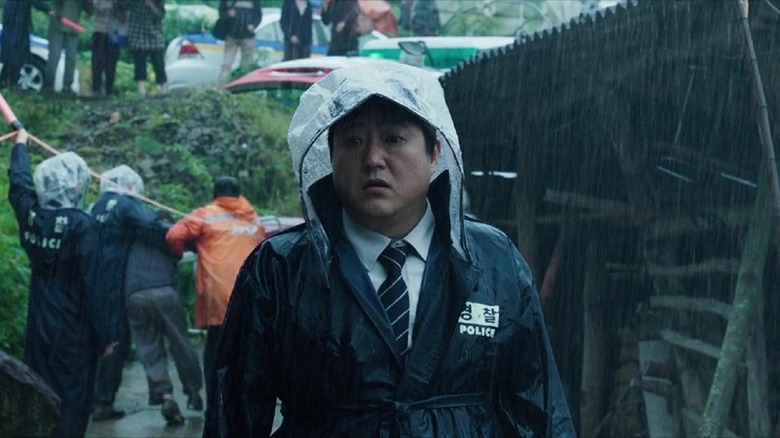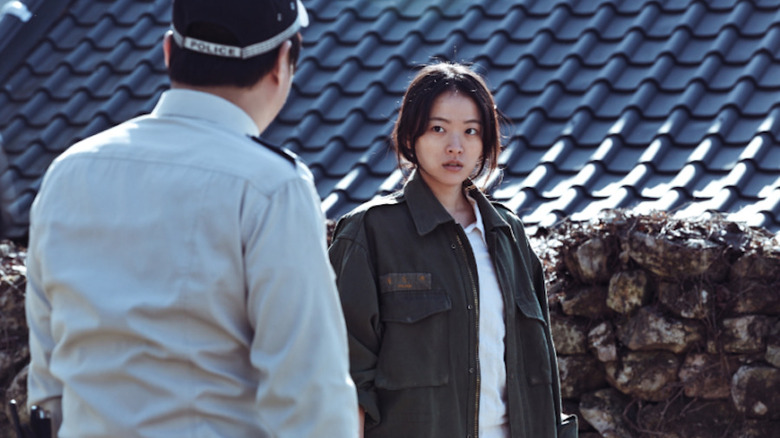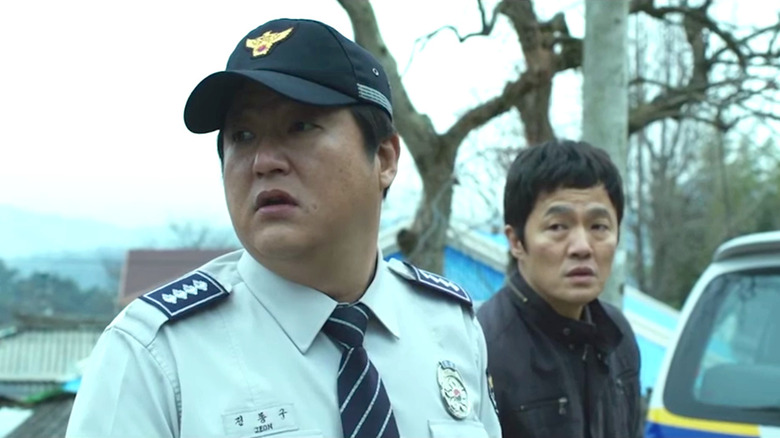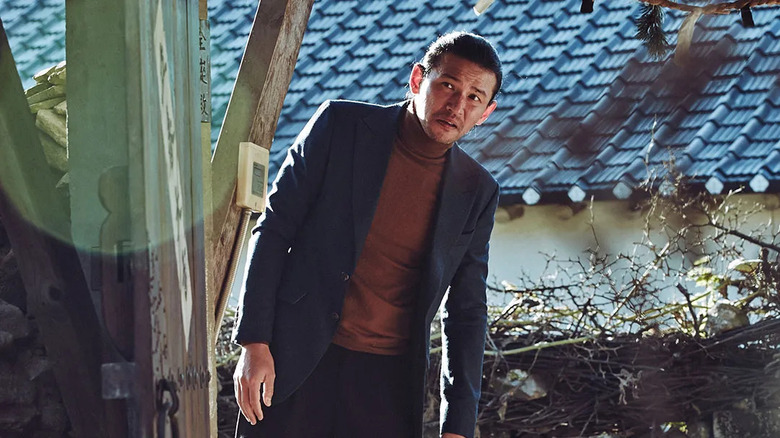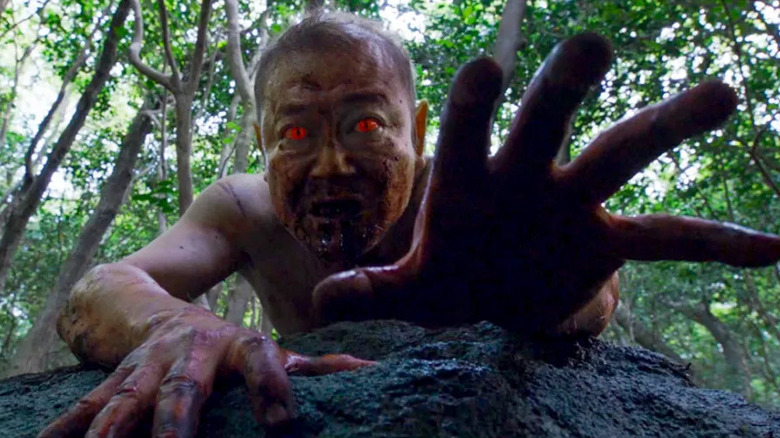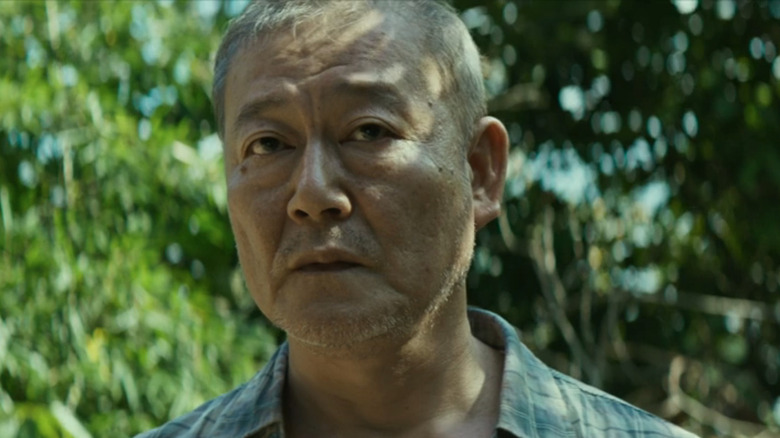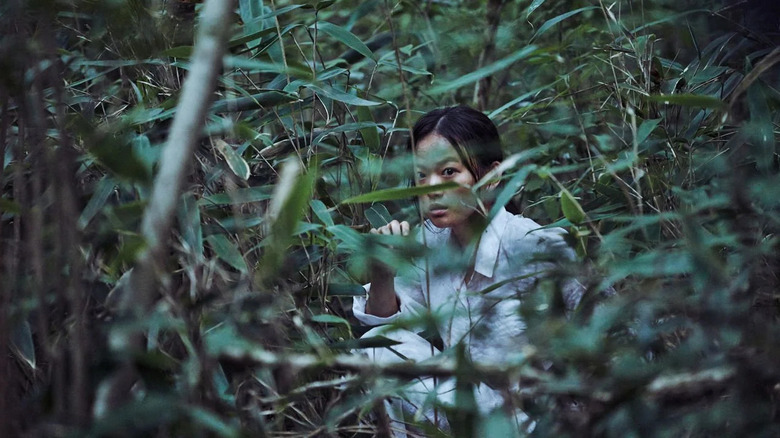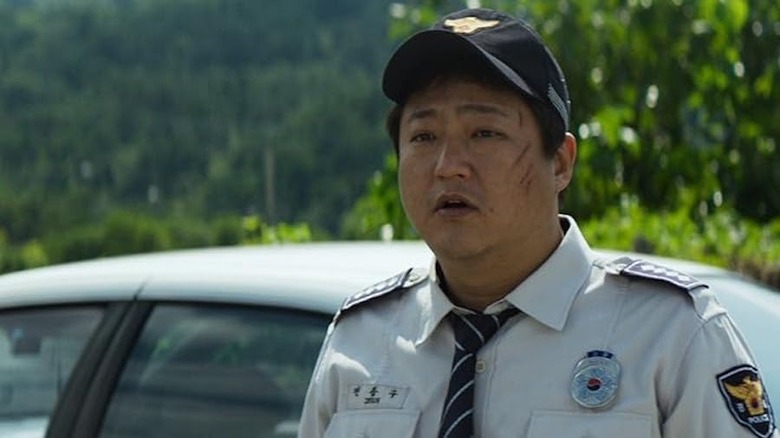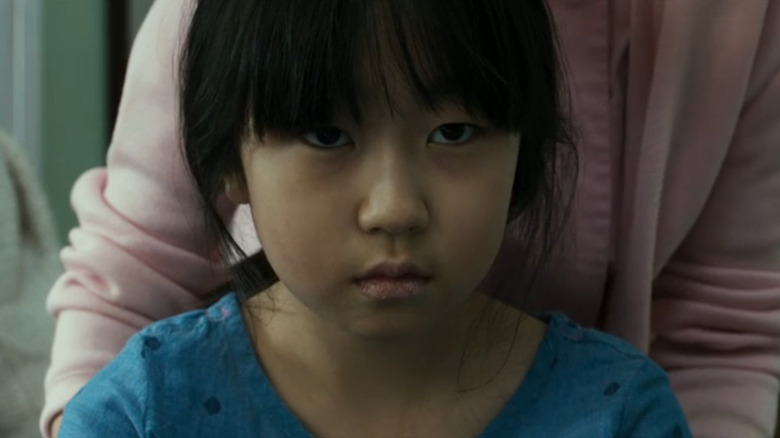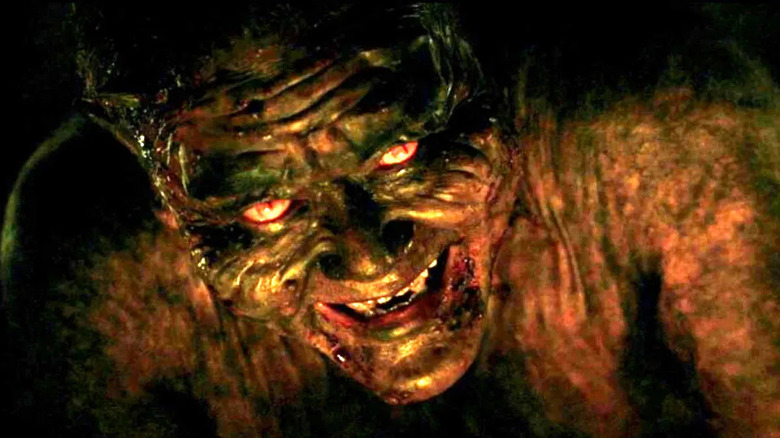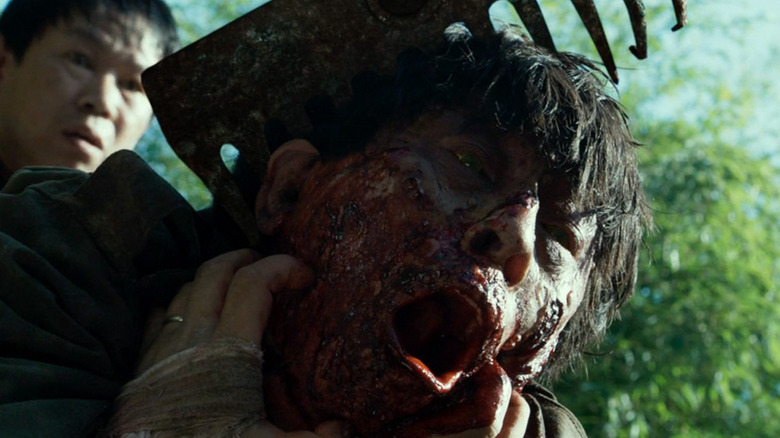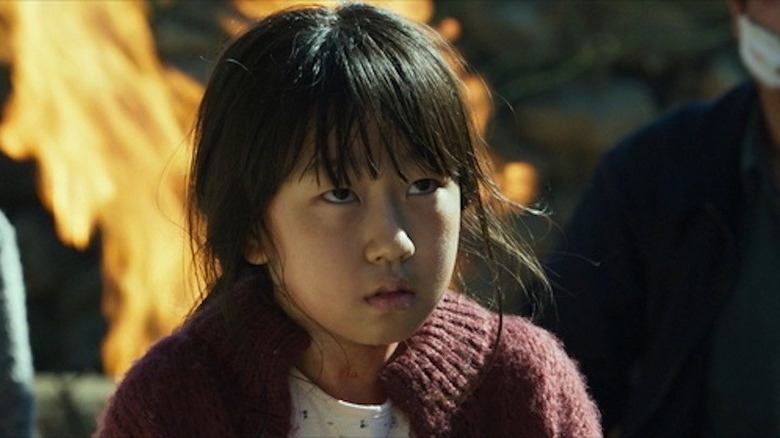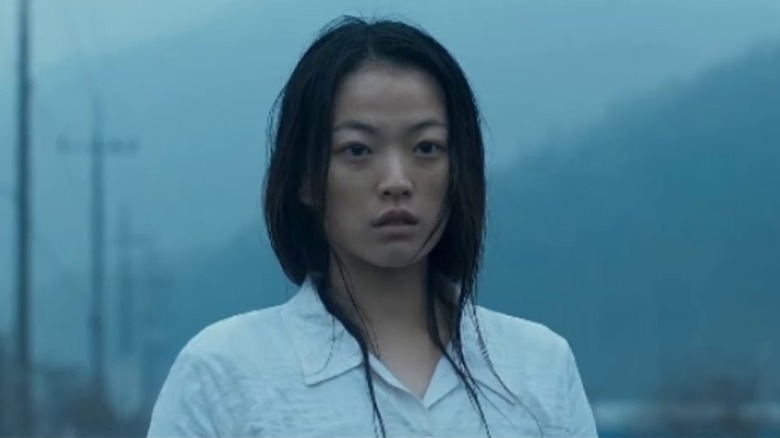The Ending Of The Wailing Explained
In 2016, South Korean writer-director Na Hong-jin unveiled "The Wailing." A mix of black comedy and blood-curdling horror, the film combines elements of zombie thriller, psychological terror, and occult horror to create what might be one of the most underappreciated Korean horror movies of all time.
The film centers on Jong-goo (Kwak Do-won), a policeman, husband, and father who is confronted with a series of unexplained and violent murders in his small village. Though the rash of violence doesn't make much sense — with otherwise ordinary townspeople suddenly turning into crazed killers — he pays it little mind until the madness hits closer to home. When it's discovered that the killing spree has coincided with the arrival of a mysterious Japanese outsider (Jun Kunimura), the case becomes much more, with talk that something supernatural may be going on.
With plenty of twists and turns and enigmatic players whose motives aren't always clear, "The Wailing" is sometimes hard to understand. A number of shocking reversals and a final act that can be interpreted in many ways means fans have been trying to make sense of it for years. If you're one of them and need a handy guide to what really went down, look no further. This is the ending of "The Wailing" explained.
What you need to remember about the plot of The Wailing
At the center of "The Wailing" are Jong-goo and the mostly inept officers of the South Korean village of Gokseong. There, a series of bizarre and violent occurrences have been plaguing the area, with unexplained murders carried out by seemingly ordinary people. Though several possible reasons are given for each apparently unrelated incident, another theory suggests that they are being caused by the recent arrival of a reclusive Japanese man living in a hut on the outskirts of Gokseong.
Though Jong-goo remains skeptical, he's forced to look harder at the cause when the plague of violence hits his home. Seeking the aid of Yang Yi-sam (Do-yoon Kim), a local deacon, Jong-goo confronts the Japanese man. However, he gets few answers and Jong-goo threatens him to leave town. The situation continues to deteriorate, though, after Jong-goo's young daughter Hyo-jin (Hwan-hee Kim) begins behaving strangely, culminating in a blistering skin condition that coincides with her own violent behavior. Meanwhile, a strange woman named Moo-myeong (Chun Woo-hee) seems to know more than anyone.
Later, Jong-goo's mother-in-law (Jin Heo) calls in a revered shaman named Il-gwang (Hwang Jung-min) who specializes in the possession of human hosts by other-worldly spirits, to rid her granddaughter of her affliction. While Jong-goo still refuses to acknowledge that something supernatural may be afoot, he's desperate to get help for his daughter, whose madness has driven her to murder her babysitter.
Jong-goo's own theories
Throughout "The Wailing," the situation for Jong-goo escalates from a local disaster to a personal crisis. Beginning with a series of unexplained murders where the perpetrators exhibit zombie-like behavior, Jong-goo — an officer who is far from well-respected by his peers — tries to make sense of the chaos any way he can. When rumors of the Japanese man — who some believe holds a supernatural sway over the village — seem to hold some truth, Jong-goo must confront his own beliefs.
At first, Jong-goo dismisses the notion that a spirit or demon is involved, even after witnessing a strange apparition firsthand and being plagued by bizarre nightmares that portend dark forces. When he confronts the Japanese man at his hut and discovers a series of photographs of the town's murderers and their victims — as well as a shoe belonging to his daughter — he doesn't know what to believe. With so much danger surrounding him, Jong-goo gives the Japanese man three days to leave town or face deadly consequences.
The Shaman's explanation
When Jong-goo first meets the shaman, he's told a remarkable story about what may be going on in Gokseong. According to Il-gwang, the Japanese man recently arrived in the village and began using demonic powers to twist the souls of the people, turning them into crazed, monstrous murderers against their will. Because the Japanese man is no man at all. According to Il-gwang, he's actually a ghost — a demon who has possessed the body of man — and whose only goal appears to be to sow death and destruction around Gokseong. If they can't stop him here and now, nobody will be left alive.
Il-gwang arrives at Jong-goo's home and quickly proves at least some of his claims are true. He exposes a curse put upon their home by the Japanese man, in the form of a dead crow hidden in a drum of soy sauce. It's this hex that has corrupted little Hyo-jin, and now it will take a powerful exorcism ritual to rid Jong-goo's daughter of the demon's influence. Unfortunately, the ritual causes Hyo-jin tremendous pain, and Jong-goo intervenes before it can be completed, allowing the demon to fight back and survive within her.
Now, Jong-goo must try to figure out the truth. Given his previous violent threats against the Japanese man, he may have further antagonized a demon or alienated the one man who could help him.
What happened at the end of The Wailing?
Having sabotaged any chance the shaman had of destroying the demon, Jong-goo returns home to discover that Hyo-jin has gone missing. Later, Jong-goo receives word from Il-gwang that they are wrong: The Japanese man wasn't the source of evil. The real demon was within Moo-myeong and she was the one terrorizing Gokseong. The Japanese man is really a shaman, who followed the demon from his homeland with the hopes of destroying the creature himself.
During his search for Hyo-jin, Jong-goo comes face to face with Moo-myeong, who he now believes could be the demon itself. But Moo-myeong insists that the shaman is lying. She is the only one who can save his daughter and to do it he must wait to return home until her trap for the demon has been laid. Torn by what to believe, Jong-goo must make a fatal choice: Rush home to save Hyo-jin from her spell as the shaman warned, or trust Moo-myeong and allow her trap to destroy the evil entity.
Unable to wait, Jong-goo races home, only to discover that Hyo-jin has murdered his entire family, and has been completely overtaken by the demon. Beside himself with grief, the film ends with Jong-goo promising to keep his now-possessed daughter safe from harm. But what really happened? Who was the demon and what did it want?
The truth about the demon, the Japanese man, and the lady in white
A horror movie with deeper themes than the standard possession story, "The Wailing" isn't the kind of film that ties up every loose end with a nice, neat, little bow. On the contrary, the ending of the film is confusing, with plenty of unanswered questions that leave it up to the viewer to decide what it means. However, there are a few answers given in the film's final moments, not the least of which is the true identity of the demon.
The shocking twist delivered by Il-gwang — that the demon was in fact the woman in white, Moo-myeong — wasn't the truth. When Yang Yi-sam confronts the Japanese man, it is revealed in no uncertain terms that he is truly a ghost — a demon in the guise of a man. As the deacon stands stupefied before him, we witness the Japanese man transform into something resembling his true form: A charred, deformed being with long nails, sharpened teeth, and blood-red eyes.
As for Moo-myeong, it's not revealed who or what she really is, though Il-gwang's false revelation suggests she was, in fact, the true shaman out to banish the demon forever. As for Il-gwang, it seems that he had been corrupted by the demon, and was helping it kill the people of Gokseong. He is seen at the end taking photographs of Jong-goo and his possessed daughter, presumably to add to the demon's collection.
What did the ending of The Wailing mean?
With plenty of questions left open at the end of "The Wailing," it's fair to wonder just what it all means. Of course, the more literal events are plain to see. The demon has succeeded in corrupting Hyo-jin, who murders her mother and grandmother, and Il-gwang has also come under its evil spell. Myoo-myeong failed in her attempt to destroy the demon, and it would seem that its goal of destroying the entire village is quickly coming to pass.
On a more thematic level, there is plenty to leave audiences pondering. The first question one might ask is why the demon came to Gokseong in the first place. One possibility is that he was drawn to the sins of its people, as suggested by Moo-myeong at the end of the film when she tells Jong-goo that it was his own sins that made his daughter a target of its evil. It may not have been Jong-goo specifically that brought the demon, but the collective sins of the townspeople, as there were a number of victims of its demonic influence before Hyo-jin.
Another question is whether the Japanese man was a demon, a ghost, or a man possessed by the devil. Though no concrete answers are given, there is enough to suggest that he was once an ordinary man — and a sinner himself, as the opening of the film shows — who was possessed by the demon to become an instrument of its will.
Are there other interpretations of the ending?
With so much ambiguity in "The Wailing," the film has become one of the most discussed Korean horror movies of the 2010s. Online forums are rife with fans discussing their interpretation of events, whether it's the true purpose of the demon, the identity of the woman in white, and the meaning of Jong-goo's nightmares — some of which are revealed to not have been dreams at all.
Another popular interpretation of the film is that the supernatural elements aren't what they seem at all, and there is a much simpler explanation for the violence that has taken over the people of Gokseong. Early in the film, one possible cause of a recent murder spree is a batch of poisonous mushrooms that sent a man insane. One theory puts forward the idea that the entire story of demons and otherworldly evil is just a smokescreen and that the killings were caused by the mushrooms. The theory elaborates that the poisonous shrooms have become a dangerous epidemic that's turned the people of Gokseong into bloodthirsty, zombie-like creatures, and everything that we see regarding demons is little more than a hallucination brought on by the mushrooms.
This theory, while far-fetched on its surface, becomes more compelling when one considers how it supports the movie's themes of hopelessness in the face of a terrifying epidemic. Whether that epidemic is from beyond or from a poisonous mushroom, there's certainly plenty of room for interpretation.
What were the themes in The Wailing?
The story of a flawed man who is desperate to save his daughter — whether it be from a dire illness or the influence of a demonic entity — "The Wailing" is full of themes that run the gamut from parenthood to religion. At the center of the story is the uncertainty of what the danger truly is, and it's this fear of the unknown that becomes the driving force of the film, leading to its ambiguous conclusion. In remaining inconclusive, "The Wailing" brings that fear to viewers, and leaves a lasting impression.
Beyond that, "The Wailing" can also be seen as a metaphor for how we cope with tragedy, not unlike the iconic horror classic "The Exorcist." Using supernatural elements, the story shows just how far a father is willing to go in order to help his daughter, who is suffering from something that he cannot make sense of. When he exhausts all rational means, he turns in desperation to the religious beliefs he'd long forsaken and is willing to work with faith-based spiritualists to save Hyo-jin, no matter how improbable it all may seem to him.
How the ending means something the director didn't intend
The film's themes of religion and family are obvious, but it's also worth commenting on the fact that the danger presented in the film comes in the form of an outsider. The Japanese man arrives in the South Korean village and is instantly the source of town rumor and gossip, lending an element of xenophobia to the story that's hard to ignore. Director Na Hong-jin, however, insists this was never on his mind. "Xenophobia has nothing to do with it," he told Screen Anarchy. For Na Hong-jin, the use of an outsider was more about the mystery of the threat. "I wanted to show this threat through someone with similar physical characteristics to Koreans," he explained, saying that it was important that the demon's human guise be similar to the Korean cast, but just different enough to cast doubt.
The director explained, "As time went by he would reveal his true nature and we would realize that he is different and that even communication is impossible. I wanted to express the fear coming from this impossibility of communication." Still, even if the idea of xenophobia weren't on Na Hong-jin's mind, it may inadvertently creep into the film for audiences — after all, the people of Gokseong are instantly suspicious of the Japanese man, who is an evil being in the form of a foreigner. He is repeatedly referred to by what many Westerners might consider a derogatory term, and their distaste for him — even long before his true nature is revealed — reveals an unintentional undercurrent of racism.
What has director Na Hong Jin said about the ending of The Wailing?
Director Na Hong-jin has talked a lot about how he crafted the ending to "The Wailing," and how different groups of audiences and their different expectations helped guide his choices. "The first group [of audiences] makes random guesses, the second absorbs the plot, and the third just can't catch up," he said in an interview with Playlist. "I wanted to satisfy all three kinds of audiences ... Sometimes I had to give up 30 to gain 70, or give up 70 to secure 30," he explained. To get the ending that satisfied the most viewers, he created multiple wrap-ups that could be interpreted in a variety of different ways. Knowing it might not work, it was the attempt that was most important to him, with Na Hong-jin saying, "I am happy with the fact that I got to try."
In addition to an ending that left audiences with something to think about and interpret themselves, its ambiguous conclusion, was something that was important to Na Hong-jin. "As a filmmaker, I believe it is my duty to show new ideas to the audience," he told Korea Joongang Daily, expressing a desire to do something fresh with each film. "I don't think repeating previous movies' successful strategies has any advantages." Ultimately, the attempt paid off handsomely, as the film and its ending wowed critics en route to becoming a box office smash.
How critics and audiences reacted to the ending of The Wailing
"The Wailing" may be one of the best-reviewed Korean horror movies of the past decade, and scores on review aggregator Rotten Tomatoes back this up. With close to 90 reviews from critics, "The Wailing" boasts a lofty 99% score, though the ending itself met with a mixed response. While Empire lauded the final act, calling it genuinely shocking and grimly inevitable, Time Out called the film's late twists "clumsily handled" — though they still gave the movie four stars.
As for movie-goers, reaction was even more divisive regarding the film's last moments, and director Na Hong-jin took notice of the hubbub on social media. Some were fresh interpretations he hadn't considered, while others matched closely what he'd had in mind. "One person explained my exact thoughts and metaphors on the internet," he told Korea Joongang Daily. But as fans fought over the film's meaning, Na Hong-jin defended those who had their own ideas and quickly realized that the audience's reaction wasn't his concern.
"I expected that there would be many different views on the movie. It is obvious when 400 people watch a movie, there will be 400 different interpretations. The opinions of those fans who enjoy watching this genre often would be especially different from those who don't."
An alternate ending to The Wailing
A couple of years after "The Wailing" was released, a deleted alternate ending to the film surfaced online, which created quite a bit of buzz among fans of the film. In this never-before-seen sequence, the Japanese man attempts to lure a little girl into his web while sitting on the side of the road before Il-gwang arrives in a car. The Japanese man gets into the passenger seat and the two drive off together, while the woman in white, Moo-myeong, looks on ominously.
Aside from further cementing the idea that Il-gwang was working with the Japanese man, this extended ending also suggests that Moo-myeong's quest to defeat them both has only just begun. So why was it deleted? Some fans have suggested that it more firmly resolves lingering ambiguity from the original version of the film. It's also hard to not view the final shot of Moo-myeong as being some kind of sequel bait, something that doesn't really feel appropriate for "The Wailing." Similarly, fans seem to agree that the final shot of Jong-goo cradling his possessed daughter was a far more emotionally gut-wrenching ending that could have been undermined by this extended scene.
